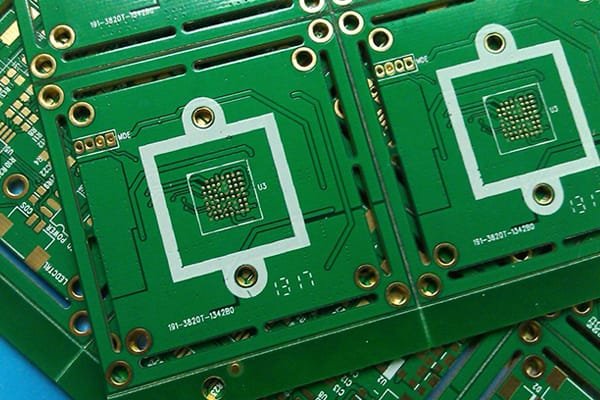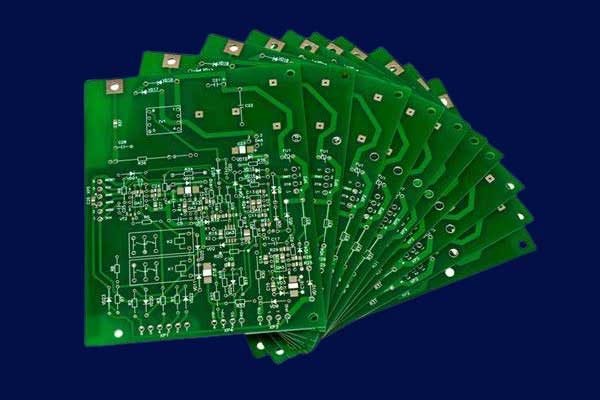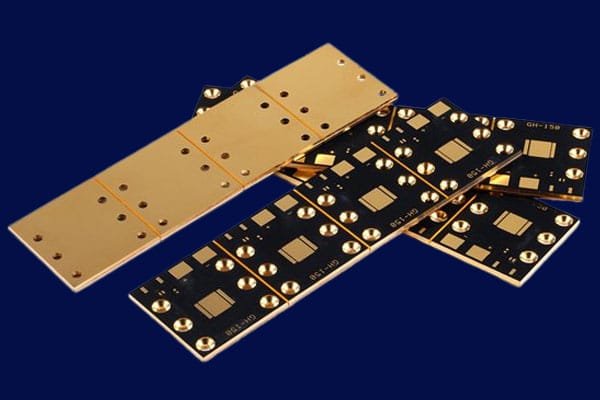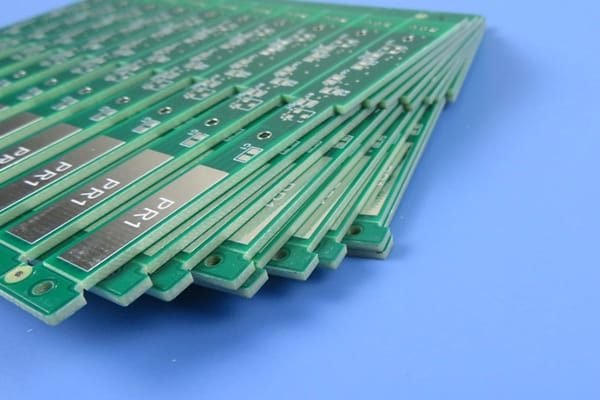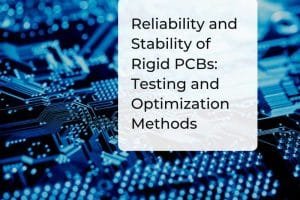
Rigid Printed Circuit Board Manufacturing Service
A Comprehensive Guide To Rigid PCB
Get your custom rigid PCBs exceptionally fast. JHYPCB offers China's highest-quality and quick-turn PCB manufacturing and assembly service.
What is a Printed Circuit Board (PCB)?
A printed Circuit Board (PCB) is a board made of insulating material, and conductive pathways etched onto its surface. It serves as a platform for electronic components to be mounted and connected to form a complete circuit.
The primary function of PCBs is to provide a physical structure for electronic components and to facilitate the flow of electricity between them. They allow for the creation of more complex electronic circuits than would otherwise be possible and enable mass production of electronic devices.
The main components of a PCB include the substrate, copper traces, and vias. The substrate is the insulating material upon which the conductive pathways are printed, while copper traces are the conductive pathways that connect electronic components. Vias are holes drilled through the substrate and plated with copper, allowing for connections between different layers of the board. Other components of a PCB may include solder masks, silkscreens, and surface mount pads.

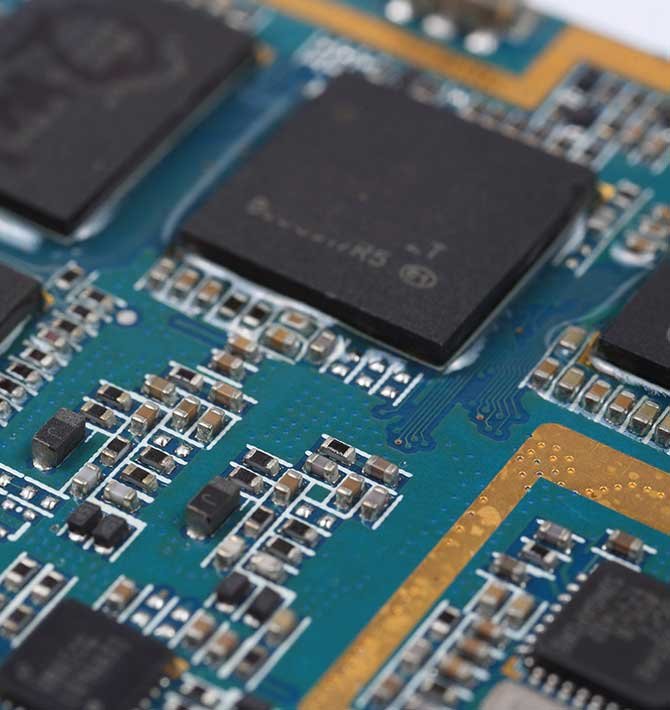
What is a Rigid PCB?
A Rigid PCB is a printed circuit board made from a solid, inflexible material. Unlike Flexible PCBs, which are made from flexible materials such as polyimide, Rigid PCBs are typically made from materials such as FR-4 fiberglass or other reinforced plastics.
The main advantage of Rigid PCBs is their ability to provide a strong, stable platform for electronic components. They are generally more durable and resistant to physical stress than flexible PCBs, which can be useful in applications where the board will be subjected to high stress or frequent use. Additionally, Rigid PCBs are typically less expensive to manufacture than flexible PCBs, making them a more cost-effective option for certain applications.
Rigid PCBs are commonly used in various electronic devices, including computers, smartphones, home appliances, and industrial equipment. They are often used in applications where a high level of electrical conductivity is required and in applications where the board will be exposed to high temperatures, moisture, or other environmental factors.
What are the Rigid PCB Advantages?
If you want to customize rigid PCB boards with cost-effective or batch orders, JHYPCB’s rigid PCB manufacturing service is the best choice. Compared with other types of circuit boards, rigid PCB boards have the following advantages:
- High structural integrity: Rigid PCBs are made from solid, inflexible materials, making them more durable and resistant to physical stress than flexible PCBs.
- Higher component density: Rigid PCBs allow for a higher density of electronic components to be mounted on the board, enabling more complex circuits to be created.
- Improved signal quality: The rigid structure of Rigid PCBs provides better signal quality and reduces the risk of signal interference and noise.
- Ease of assembly: Rigid PCBs are typically easier to assemble than flexible PCBs, which can require specialized equipment and techniques.
- Cost-effective: Rigid PCBs are generally less expensive to manufacture than flexible PCBs, making them a more cost-effective option for certain applications.
- High temperature resistance: Rigid PCBs are able to withstand high temperatures, making them suitable for use in high-heat applications, such as High Tg FR-4 PCB.
- Better mechanical stability: The rigidity of Rigid PCBs allows for better mechanical stability, reducing the risk of component displacement or failure.
- Easier to repair: Rigid PCBs are easier to repair than flexible PCBs, as damaged components can be more easily replaced or repaired on a solid board.
What are the Rigid PCB Applications?
Rigid PCBs are used in a wide range of electronic applications, including:
- Consumer electronics: Rigid PCBs are used in a variety of consumer electronic devices, such as smartphones, tablets, laptops, and televisions.
- Automotive electronics: Rigid PCBs are used in the electronic systems of automobiles, including engine control units, infotainment systems, and driver assistance systems.
- Industrial electronics: Rigid PCBs are used in a variety of industrial applications, such as control systems for manufacturing equipment and automation systems.
- Aerospace and defense electronics: Rigid PCBs are used in the electronic systems of aircraft, satellites, and other aerospace and defense applications.
- Medical electronics: Rigid PCBs are used in medical equipment such as patient monitors, imaging systems, and diagnostic equipment.
- Telecommunications equipment: Rigid PCBs are used in telecommunications equipment such as routers, switches, and base stations.
- Power electronics: Rigid PCBs are used in power electronics applications such as inverters, converters, and power supplies.
- LED lighting: Rigid PCBs are used in LED lighting applications, such as in light strips and high-power LED lighting fixtures.
What are the Types of Rigid PCB?
There are several types of Rigid PCBs, which are differentiated by their construction and specific use cases. Some of the most common types of Rigid PCBs include:
- Single-sided PCBs: This type of Rigid PCB has conductive pathways on only one side of the board, and electronic components are mounted on the same side. They are commonly used in low-cost, low-complexity applications.
- Double-sided PCBs: Double-sided Rigid PCBs have conductive pathways on both sides of the board, which allows for a higher density of electronic components to be mounted. They are more complex and expensive to manufacture than single-sided PCBs but are commonly used in a wide range of applications.
- Multilayer PCBs: Multilayer Rigid PCBs have multiple layers of conductive pathways and insulating material, allowing for an even higher density of electronic components to be mounted. They are commonly used in high-density applications, such as in computer motherboards or telecommunications equipment.
- High-frequency PCBs: These Rigid PCBs are specifically designed to operate at high frequencies, such as in radio or microwave applications. They are constructed with specialized materials and design techniques to ensure optimal performance at high frequencies.
- Metal-core PCBs: Metal-core Rigid PCBs have a metal core layer, usually made of aluminum, which provides better heat dissipation and thermal management. They are commonly used in high-power LED lighting applications.
- HDI (High-Density Interconnect) PCBs: These Rigid PCBs are designed to provide high-density connections between electronic components, with very fine trace widths and spacings. They are commonly used in high-speed and high-performance applications, such as in smartphones or high-end computing equipment.
What is the Structure of Rigid PCB?
The structure of a Rigid PCB (Printed Circuit Board) typically includes the following components:
- Substrate: The substrate is the base material upon which the conductive pathways and electronic components are mounted. It is usually made of a rigid, non-conductive material such as FR-4 fiberglass or other reinforced plastics.
- Conductive pathways: These are the copper traces that connect the electronic components on the PCB. They are usually etched onto the surface of the substrate using a chemical process, and can be single-sided, double-sided, or multilayered.
- Vias: Vias are small holes drilled through the substrate, which are then plated with copper to allow for connections between different layers of the PCB. They are used to facilitate the flow of electrical current between layers and components.
- Solder mask: The solder mask is a layer of material that is applied over the conductive pathways to protect them from accidental soldering or other damage during assembly. It is typically a green or black color and has openings for the electronic components to be mounted.
- Silkscreen: The silkscreen is a layer of ink or paint applied to the surface of the PCB to indicate component placement, part numbers, and other information related to the assembly of the board.
- Surface mount pads: These are areas of exposed copper on the PCB where electronic components can be mounted using a soldering process. They are typically rectangular or circular in shape and can be located on either side of the board.
- Electronic components: These are the active and passive components that are mounted on the PCB to create an electronic circuit. They include resistors, capacitors, diodes, transistors, integrated circuits, and other devices.
Rigid PCBs consist of multiple layers that are bonded together using adhesives and heat to form a strong, solid structure. The finished board typically consists of four layers, which include the substrate, copper, solder mask, and silkscreen, arranged in a specific order from bottom to top.
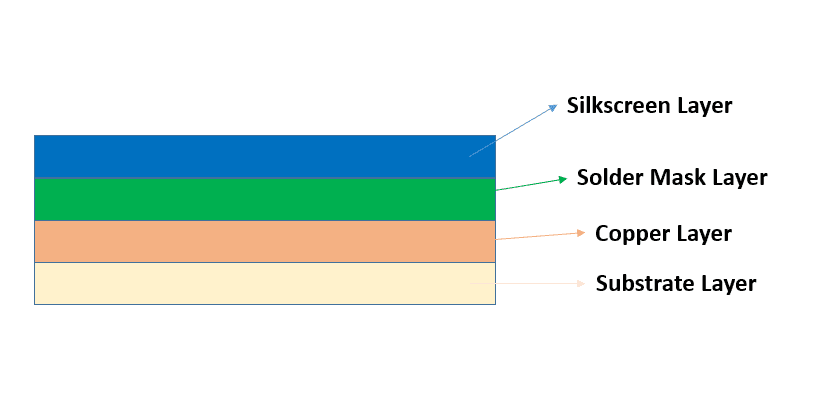
What are the Rigid PCB Thickness?
Rigid PCBs are available in a variety of thicknesses, which are typically measured in millimeters (mm) or mils (thousandths of an inch). The most common thicknesses for Rigid PCBs include:
0.8mm (31.5 mils)
1.0mm (39.4 mils)
1.2mm (47.2 mils)
1.6mm (63 mils)
2.0mm (78.7 mils)
2.4mm (94.5 mils)
3.2mm (126 mils)
However, it’s important to note that the actual thickness of a Rigid PCB can vary depending on the specific design requirements and manufacturing process. Additionally, some manufacturers may offer custom thicknesses for specific applications. It’s always important to consult with us to ensure that the chosen thickness is suitable for the specific application and design requirements.
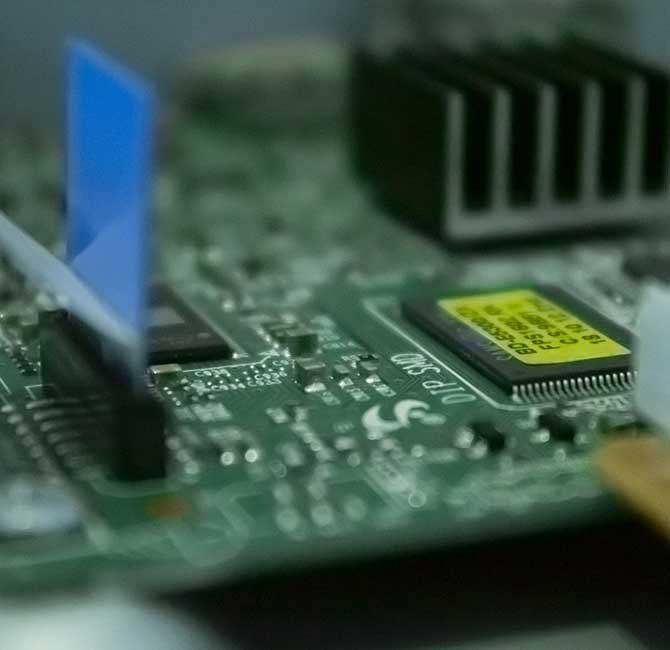
What are the Rigid PCB Materials?
Rigid PCBs can be made from a variety of materials, depending on the specific application and design requirements. Some common materials used in Rigid PCB manufacturing include:
- FR-4 (Flame Retardant 4): This is the most common material used for Rigid PCBs, consisting of a woven fiberglass cloth with an epoxy resin binder. FR-4 is known for its excellent electrical insulation properties, good mechanical strength, and high-temperature resistance.
- Rogers laminates: These laminates are made from a variety of high-performance materials, such as ceramic-filled PTFE (Polytetrafluoroethylene), and are known for their high-frequency capabilities, low dielectric constant, and low loss tangent.
- Aluminum: Aluminum-backed PCBs are used in applications where high thermal dissipation is required, such as LED lighting and power electronics.
- Copper: Copper-backed PCBs are used in applications where high electrical conductivity is required, such as high-current power supplies and motor control circuits.
- Ceramic: Ceramic PCBs are used in applications where high thermal conductivity, high-temperature resistance, and high reliability are required, such as in aerospace and defense electronics.
- Other materials: Other materials used in Rigid PCB manufacturing include polyimide, Teflon, and other specialty materials, depending on the specific application and design requirements.
Rigid PCB Manufacturing Process
The manufacturing process for Rigid PCBs typically involves the following steps:
- Printing the inner layer: The inner layer of the PCB is typically printed using a process called photoengraving. This involves coating a layer of copper onto the substrate and then using a photoresist to create a pattern of the circuitry. The copper is then etched away, leaving behind the circuitry on the inner layer.
- Drilling: After the inner layer has been printed, the PCB is drilled to create holes for the through-hole components and vias. The holes are typically drilled using a computer-controlled drilling machine.
- Electroplating: Once the holes have been drilled, the PCB is electroplated to add a layer of copper to the walls of the holes and the surface of the inner layer. This creates a conductive path between the layers of the PCB.
- Printing the outer layer: The outer layer of the PCB is printed using the same process as the inner layer. This involves coating the substrate with copper, applying a photoresist, and then etching away the unwanted copper to create the circuitry.
- Solder mask and silkscreen: The solder mask is then applied to the surface of the PCB to protect the circuitry from accidental soldering. The silkscreen layer is also applied at this stage to add text, labels, and other markings to the PCB.
- Final drilling: Any additional holes that were not drilled in the previous steps are drilled at this stage, such as mounting holes or test points.
- Surface finish: The final step in the manufacturing process is to apply a surface finish to the PCB to protect it from oxidation and facilitate soldering. This can include a variety of finishes, such as hot air leveling, immersion gold, or OSP.
- Once the surface finish has been applied, the PCB is inspected for defects and then shipped to the customer for assembly. The entire manufacturing process can take several days to several weeks, depending on the complexity of the PCB and the volume of production.
Comparison between Rigid and Flexible PCBs
Rigid PCBs and Flex PCBs are two types of circuit boards that are used in electronic devices. The main difference between them is their flexibility.
Rigid PCBs are made of a rigid material, such as fiberglass or a similar composite material. They cannot be bent or twisted and are used in applications where the board must remain flat and stable, such as in desktop computers or televisions.
Flex PCBs, on the other hand, are made of a flexible material, such as a thin plastic film. They can be bent or twisted to fit into tight spaces or to allow for movement in an electronic device. They are commonly used in devices such as smartphones, cameras, and wearables.
Another difference is that rigid PCBs are typically less expensive to manufacture than flex PCBs, but flex PCBs offer more design flexibility and can be customized to fit specific device requirements.
| Feature | Rigid PCB | Flex PCB |
|---|---|---|
| Material | Rigid substrates such as FR4 or CEM-1 | Flexible substrates such as polyimide or PET |
| Flexibility | Not flexible | Highly flexible and can be bent or twisted |
| Thickness | Generally thicker than flex PCBs | Generally thinner than rigid PCBs |
| Component Placement | Components are placed on one side only | Components can be placed on both sides of the PCB |
| Applications | Suitable for applications where rigidity is required, such as computer motherboards, telecommunication equipment, and industrial controls | Suitable for applications that require flexibility, such as wearable electronics, medical devices, and automotive systems |
| Manufacturing Process | Conventional PCB fabrication processes, including drilling and plating | Requires specialized processes, such as roll-to-roll manufacturing, to create flexible circuits |
| Cost | Typically less expensive than flex PCBs | Typically more expensive than rigid PCBs due to specialized manufacturing processes and materials |
| Reliability | Rigid PCBs tend to be more reliable due to their robustness and stable design | Flex PCBs may be less reliable due to their vulnerability to cracking, bending, and twisting |
| Design Complexity | Limited design options due to the lack of flexibility | Greater design flexibility due to the ability to bend and twist the PCB |
| Environmental Stability | More stable in harsh environments due to the rigidity of the substrate | Can withstand harsh environments due to the flexibility of the substrate |
| Size | Generally used for larger PCBs | Generally used for smaller PCBs or in situations where space is limited |
Your Trusted Rigid PCB Manufacturer
Welcome to our Chinese PCB factory – your trusted partner for high-quality Rigid PCB manufacturing. With over a decade of experience in the industry, we specialize in delivering top-notch PCB prototypes and mass production services, including Rigid PCBs, Flexible PCBs, Metal Core PCBs, Heavy Copper PCBs, and LED PCBs.
At our state-of-the-art facility, we utilize advanced manufacturing equipment and cutting-edge technology to produce Rigid PCBs that meet the highest standards of quality and reliability. Our team of skilled professionals is committed to delivering superior results and exceeding our customers’ expectations.
We pride ourselves on providing exceptional customer service, fast turnaround times, and competitive pricing to ensure that our customers receive the best value for their investment. We also offer a wide range of customization options, including material selection, board thickness, and surface finish, to meet the unique needs of our clients.
Whether you need a prototype for a new product or require mass production of Rigid PCBs, we have the capabilities and expertise to get the job done right, the first time. Contact us today to learn more about our Rigid PCB manufacturing services and take the first step towards turning your ideas into reality.
Rigid PCB Manufacturing Capability
| Manufacturing Capability | Specification | Layer count | Single-sided, double-sided, or up to 64 layers multi-layer PCBs |
|---|---|
| Board thickness | 0.4mm to 4.0mm, with most common thicknesses of 1.0mm, 1.2mm, and 1.6mm |
| Copper weight | 0.5 oz to 20 oz |
| Minimum line width/space | 3 mils to 6 mils |
| Minimum hole size | 0.15mm |
| Surface finish | HASL, ENIG, OSP, Immersion Tin, Immersion Silver |
| Silkscreen | White or black legend ink, with the option for additional colors |
FAQs
What is a Rigid PCB?
A Rigid PCB is a type of circuit board that is made from a rigid substrate material, such as fiberglass or composite epoxy.
What types of Rigid PCBs are available?
There are several types of Rigid PCBs available, including single-sided, double-sided, multi-layer, and high-density interconnect (HDI) PCBs.
What materials are used to make Rigid PCBs?
The most common materials used to make Rigid PCBs are fiberglass and composite epoxy. Other materials such as metal cores and ceramic substrates can also be used for specialized applications.
What are the quality control measures taken during Rigid PCB manufacturing?
Quality control measures taken during Rigid PCB manufacturing include in-process inspections, final inspections, electrical testing, and quality audits to ensure that the final product meets the customer's requirements and industry standards.
What is the typical lead time for Rigid PCB manufacturing?
The lead time for Rigid PCB manufacturing can vary depending on the complexity of the design, the number of layers, and the quantity required. However, with modern manufacturing techniques and processes, lead times have significantly reduced, and Rigid PCBs can be produced within a few days.
Can Rigid PCBs be customized to fit specific requirements?
Yes, Rigid PCBs can be customized to fit specific requirements, such as material selection, board thickness, copper weight, and surface finish. Customization options allow for better design flexibility and ensure that the final product meets the customer's specific needs.
Do you offer Multilayer Rigid PCB Manufacturing Service?
Absolutely. Whether your requirement is for single layer, double-sided or multilayer rigid PCBs(up to 64 layers), we have you covered.
Do you provide prototype quantities for Rigid PCBs?
Yes, you can count on us to offer you prototype quantities with the same unstinting focus on quality.
Are your prices effective for Rigid PCBs?
Yes. We offer you the most cost-effective quote for Rigid PCBs?


